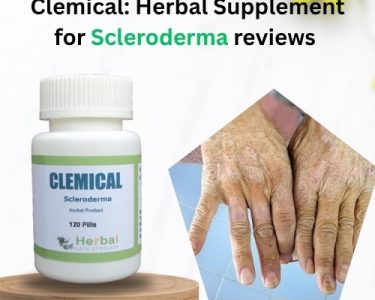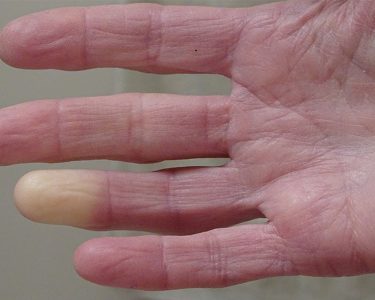Scleroderma is a rare autoimmune disorder that causes hardening and tightening of the skin and connective tissues. While it is often associated with skin changes, scleroderma can also affect internal organs and various body systems, including the eyes. The condition’s impact on vision and eye health is often overlooked, yet it plays a crucial role in a patient’s overall quality of life.
In this detailed guide, we’ll explore how scleroderma eye disease develops, how it affects scleroderma eyelids, the role of scleroderma eyes in vision complications, and how natural remedies can support comfort and long-term eye health. We’ll also discuss both medical and Natural Remedies for Scleroderma that can help reduce discomfort and protect vision.
Understanding Scleroderma and Its Effects on the Eyes
Scleroderma, which means “hard skin,” is caused by an overproduction of collagen, an essential protein that provides structure and elasticity to the skin and connective tissues. When excess collagen builds up, it causes thickening and tightening not only of the skin but also of internal organs, blood vessels, and mucous membranes, including those around the eyes.
When scleroderma affects the eyes, it can involve:
- The eyelids, causing stiffness and reduced flexibility
- The tear glands, leading to dryness and irritation
- The conjunctiva and cornea, resulting in inflammation or scarring
- The small blood vessels affect blood flow and tissue health
This combination of effects can cause significant discomfort, dryness, and even visual disturbances.
1. Scleroderma and Eyelid Involvement
One of the most visible signs of scleroderma’s effect on eye health is changes in the scleroderma eyelids. The eyelids are delicate structures that play a critical role in protecting and lubricating the eyes. When they are affected by fibrosis (thickening of connective tissue), it can cause a range of problems:
A. Tightening and Stiffness
Patients with scleroderma often develop thickened or tight eyelid skin. This tightening limits the eyelids’ ability to open and close fully. In severe cases, patients struggle to blink completely, which can lead to exposure keratitis, a condition where the cornea becomes dry and inflamed because it’s not properly protected by the eyelids.
B. Reduced Blink Reflex
A stiff eyelid limits blinking frequency, reducing natural tear distribution across the eye surface. The result is persistent dryness, redness, and irritation, which can worsen over time.
C. Changes in Facial Expression
Fibrosis of the eyelids and facial skin can also alter expressions, creating a mask-like appearance. This tightening not only affects cosmetic appearance but also impacts eye comfort and moisture balance.
Related article: Clemical: Best Herbal Supplement for Scleroderma reviews
2. Scleroderma Eyes: Dryness, Inflammation, and Vision Changes
When discussing scleroderma eyes, dryness and inflammation are the two most common symptoms reported by patients. These symptoms stem from the autoimmune process that damages the glands and tissues responsible for maintaining moisture and eye health.
A. Dry Eyes (Keratoconjunctivitis Sicca)
Dryness is often one of the earliest and most noticeable symptoms. The tear glands (lacrimal glands) become inflamed or fibrotic, reducing tear production. Without adequate tears, the eyes can feel gritty, itchy, or burning. Chronic dryness can lead to:
- Blurred vision
- Corneal abrasions
- Light sensitivity (photophobia)
- Increased risk of infection
B. Inflammation of the Conjunctiva and Cornea
Inflammation can occur on the surface of the eye (conjunctiva) or deeper layers (cornea). This inflammation may cause redness, swelling, pain, and sometimes even scarring, which can impair vision.
C. Blood Vessel Damage
Scleroderma affects small blood vessels throughout the body, including those that nourish the eye. Reduced blood flow can lead to ischemic damage, limiting oxygen and nutrient supply to vital eye tissues. This may accelerate eye aging and worsen dryness.
3. Scleroderma and Eyes: Systemic Links
The connection between scleroderma and the eyes goes beyond localized symptoms. Eye changes often mirror the systemic disease activity and can be early warning signs of disease progression.
A. Secondary Sjögren’s Syndrome
Many scleroderma patients develop secondary Sjögren’s syndrome, another autoimmune condition that primarily affects moisture-producing glands. This overlap significantly increases eye dryness and mouth dryness. Managing both conditions simultaneously is crucial to maintaining comfort and preventing complications.
B. Raynaud’s Phenomenon of the Eyes
Just as Raynaud’s phenomenon affects blood flow to fingers and toes, it can also affect blood flow to ocular tissues. Reduced circulation can cause intermittent eye discomfort and color changes in the eyelids or surrounding skin.
C. Orbital Involvement
In rare cases, scleroderma may extend deeper into orbital tissues, causing swelling or limited eye movement. This can result in double vision (diplopia) or eye pain.
Related article: Scleroderma: Diagnosis, Treatment, and Care
4. Common Eye Symptoms in Scleroderma Patients
Patients with scleroderma may experience various eye-related symptoms depending on disease severity and type. Some of the most common symptoms include:
- Dryness and burning sensation
- Red or irritated eyes
- Blurred vision
- Difficulty closing eyelids completely
- Light sensitivity
- Eye fatigue or strain
- Feeling of grit or sand in the eyes
- Swelling around the eyes or eyelids
Recognizing these symptoms early and seeking appropriate care can prevent long-term damage and improve quality of life.
5. Diagnosis and Eye Evaluation
Ophthalmologists use several tests to assess scleroderma eyes and determine the extent of dryness or inflammation:
A. Schirmer Test
This simple test measures tear production using a small strip of paper placed under the eyelid.
B. Fluorescein Staining
A dye is used to detect damage to the corneal surface caused by dryness or inflammation.
C. Tear Film Break-Up Time (TBUT)
This test evaluates tear stability and how quickly the tears evaporate from the eye surface.
D. Slit-Lamp Examination
A microscope allows the eye doctor to inspect the cornea, conjunctiva, and eyelids for signs of fibrosis, scarring, or inflammation.
6. Conventional Treatments for Scleroderma Eye Disease
Treatment focuses on managing symptoms and preventing complications rather than curing the disease. Common approaches include:
A. Artificial Tears and Lubricants
Regular use of preservative-free artificial tears helps combat dryness and irritation. Ointments can be applied at night for prolonged moisture.
B. Anti-Inflammatory Medications
Eye drops containing corticosteroids or cyclosporine (e.g., Restasis) can reduce inflammation and improve tear gland function.
C. Punctal Plugs
Small plugs inserted into the tear ducts help retain natural tears, improving moisture retention.
D. Moisture Chamber Glasses
These specialized glasses protect eyes from wind and evaporation, maintaining a more humid environment.
E. Eyelid Surgery
In cases of severe tightening, surgery may be necessary to restore eyelid function and allow complete closure.
Related article: Best Diet Plan for Patients of Scleroderma
7. Natural Remedies for Scleroderma Eye Symptoms
While medical treatment is essential, many patients find relief from Natural Remedies for Scleroderma, particularly for managing eye symptoms and improving comfort. Always consult your healthcare provider before trying new remedies, especially if you’re on medication.
A. Omega-3 Fatty Acids
Found in fish oil, flaxseeds, and walnuts, omega-3s reduce inflammation and support tear production. Regular supplementation may help ease eye dryness and improve lubrication.
B. Warm Compresses
Applying a warm compress to the eyes helps stimulate oil gland function and relieve tightness around the scleroderma eye disease.
C. Aloe Vera Gel
Known for its anti-inflammatory and hydrating properties, aloe vera can soothe skin around the eyes. Use only pure, organic gel and avoid direct contact with the eyes.
D. Cucumber or Green Tea Compress
Cucumber slices or chilled green tea bags can reduce puffiness and inflammation, providing a refreshing natural relief.
E. Humidifier Use
Adding moisture to indoor air can significantly reduce eye dryness, especially in winter or air-conditioned environments.
F. Vitamin E and C
These antioxidants protect eye tissues from oxidative stress and improve collagen health, which is essential for connective tissue resilience.
G. Herbal Support
Herbs like turmeric, ginger, and ginkgo biloba may improve blood circulation and reduce inflammation, offering systemic benefits for scleroderma-related eye issues.
8. Eye Care Tips for Patients with Scleroderma
Lifestyle modifications and consistent care can greatly reduce discomfort and prevent long-term complications.
- Stay Hydrated: Drink plenty of water to maintain moisture balance.
- Avoid Smoke and Wind: These environmental factors worsen dryness.
- Take Frequent Breaks: If you work at a computer, follow the 20-20-20 rule (every 20 minutes, look at something 20 feet away for 20 seconds).
- Use Nighttime Ointments: These prevent overnight dryness when the eyelids don’t close completely.
- Protect from UV Rays: Wear sunglasses outdoors to protect against wind and sun exposure.
- Eat Anti-Inflammatory Foods: Focus on fruits, vegetables, and omega-rich foods.
- Avoid Harsh Cosmetics: Use gentle, hypoallergenic products around the eyes.
9. The Importance of Regular Eye Checkups
Because eye symptoms can progress silently, regular visits to an ophthalmologist familiar with autoimmune diseases are crucial. Early intervention can prevent irreversible damage and preserve sight.
Doctors may recommend checkups every 6 to 12 months, depending on disease severity. Patients with secondary Sjögren’s syndrome or advanced scleroderma may require more frequent monitoring.
10. Living with Scleroderma and Protecting Eye Health
Living with scleroderma is challenging, but proactive care can make a significant difference. Addressing scleroderma and the eyes early ensures better comfort and long-term protection. Combining medical care with Natural Remedies for Scleroderma, such as proper nutrition, hydration, and natural inflammation control, helps balance immune function and support eye tissues.
Remember, maintaining a positive mindset and staying consistent with your eye care routine can go a long way toward improving your quality of life.
Conclusion
Scleroderma doesn’t only affect the skin—it extends to multiple organs and systems, including the eyes. Tight scleroderma eyelids, chronic dryness, and inflammation can all impact vision and daily comfort. However, with timely diagnosis, medical treatment, and supportive Natural Remedies for Scleroderma, patients can significantly improve eye health and prevent complications.
If you’re experiencing symptoms such as dryness, irritation, or difficulty blinking, consult an ophthalmologist experienced in autoimmune diseases. Early management is the key to preserving vision and comfort in scleroderma eye disease.
By blending medical and natural approaches, you can effectively care for your scleroderma eyes and protect one of your most vital senses, your vision.




